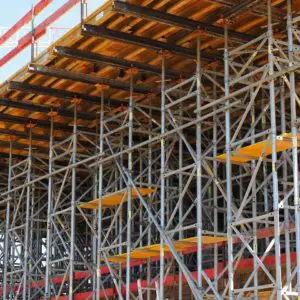Each day, thousands of people enter and leave numerous buildings, never really stopping to consider what it took to build the structure or what it continues to take in order to maintain the building. Even when walking under scaffolding, visitors typically ignore these structures, not realizing that the scaffolding workers are helping keep a building in good shape. Or that those same workers are often put in terrible danger.
The years working in the legal field have allowed our scaffolding accident lawyers to become experienced in this part of the law.
A broad perspective over varied cases has shown that the most common mechanisms of injury are falling from scaffolding or being struck by objects dropped from scaffolding. These types of incidents often result in personal injuries such as:
Each of these injuries is expensive to treat. So how can scaffolding accident victims recover compensation that will allow them to get the best care possible for the rest of their life?
A personal injury lawsuit is an avenue posed by the civil justice system. However, depending on the circumstances of the accident, a workers' compensation claim may be the only way to secure benefits.
When it comes to scaffolding-related safety regulations, the Occupational Safety and Health Administration (OSHA) has set standards that must be complied with while erecting and using the scaffolding. A few examples of the general requirements for scaffolding set forth by OSHA include: 
A full set of dozens of scaffolding regulations can be found on OSHA’s website.
Scaffolding accidents can be caused by a variety of factors, but some are more common than others.
One of the most significant factors is improper installation or assembly of the scaffold. If the scaffold is not set up correctly, it can collapse or shift, causing workers to fall and sustain serious injuries.
Another common cause of scaffolding accidents is inadequate training and supervision. Workers who are not properly trained on how to use scaffolding equipment or who are not supervised while working on scaffolds are more likely to make mistakes that can lead to accidents.
Next, environmental factors can also contribute to scaffolding accidents. High winds, rain, and snow can make scaffolds unstable and increase the risk of falls. Additionally, uneven ground or surfaces can cause scaffolds to tilt or collapse.
Finally, human error is a significant factor in many scaffolding accidents. Workers who are distracted, fatigued, or under the influence of drugs or alcohol are more likely to make mistakes that can lead to accidents. It is essential for workers to remain focused and alert while working on scaffolds to prevent accidents from occurring.
As you already understand, scaffolding is essential in the construction industry. Nevertheless, it remains a significant hazard if not used correctly.
According to the Occupational Safety and Health Administration (OSHA), scaffolding accidents account for many injuries and fatalities in the construction industry. Therefore, taking the necessary precautions to prevent scaffolding injuries is crucial.
One of the most important steps in preventing scaffolding injuries is erecting the scaffold correctly. The scaffold should be erected on a stable and level surface, and all components should be securely fastened. It is also essential to inspect the scaffold regularly to ensure that it remains stable and secure.
Proper training is another vital element. All workers working on or around scaffolding should receive comprehensive training on using it safely. This training should include how to erect and dismantle the scaffold, how to use personal protective equipment (PPE), and how to identify potential hazards. Along the same vein, using appropriate PPE when working on or around scaffolding is also essential. This includes hard hats, safety glasses, and non-slip footwear. Specifically, workers should use fall protection equipment such as harnesses and lanyards when working at heights.
A final measure for ensuring safety and preventing injuries is the implementation of a comprehensive safety program. Such programs will include regular inspections, hazard assessments, and incident reporting procedures. Naturally, these programs should be communicated clearly to all workers, and they should be encouraged to report any safety concerns or incidents immediately.
The reality is that construction is booming, and construction workers are in high demand. To save companies time and money, many employers push employees to skip steps when building, using, and dismantling scaffolding. Skipping these necessary steps puts construction workers in danger and causes serious accidents.
When a construction worker is injured on the job, they have the right to apply for workers’ compensation insurance coverage. This insurance is supposed to pay for the medical expenses that relate to the work injury and, if necessary, a fraction of lost earnings.
Employers are required by law to have coverage for their employees. If they do not, they risk a construction accidents lawsuit. But such accident lawsuits are not only filed against negligent employers. These civil lawsuits can also be filed against a negligent third party and are an opportunity to recover full compensation for lost wages, comprehensive medical expenses, physical pain, and emotional trauma ("pain and suffering").
It’s also important to remember that innocent bystanders come into contact with poorly constructed scaffolding on a daily basis. Anyone who is hurt in a scaffolding accident, even a passing pedestrian on the street, has the right to take legal action against the responsible party.
Yes, it is possible to file both a workers’ compensation claim and a construction accident lawsuit simultaneously. They are two separate claims.
It is generally advised to seek the insight of a personal injury law firm whenever individuals are involved in some sort of injury-producing accident.
Regardless of whether the injury is produced outside of work or inside of it, such as at a construction site populated with scaffolds, an experienced lawyer will be able to analyze your circumstances and lay out your options.
While they may be versed in labor law, most victims of scaffolding accidents are unlikely to be intimate with scaffolding injury case law. This is where an experienced accident law firm can help. By leveraging their past experience, a legal team can guide you through the process and help you build a knowledgeable case.





A client of Schuster Law

My husband and I were in a car accident and our car got t-boned. Andrew Valentin was the lawyer we chose to represent us. Andrew fought on our behalf with the other party's insurance company, making sure everything was made right. Between regular check-ins on us and follow through on the case, Andrew made sure we were well taken care of.
Laura VM
A Car Accident Client of Schuster Law
